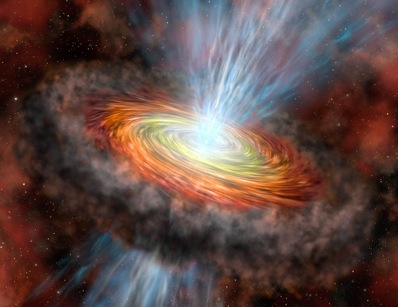


|

|
 |
|
A giant star in the making KEITH COOPER ASTRONOMY NOW Posted: 14 April New observations of a massive star caught in the midst of being born are providing further evidence that big stars and small stars form in exactly the same way. Ben Davies from the University of Leeds presented new images of the giant protostar W33A at the RAS’ National Astronomy Meeting this week at the University of Glasgow.  An artistic impression of the torus and jets of W33A. Image: Gemini Observatory/Lynette Cook. An artistic impression of the torus and jets of W33A. Image: Gemini Observatory/Lynette Cook.
Low mass stars form through a process of fragmentation and gravitational collapse inside a giant cloud of molecule hydrogen. “The question has always been, do high mass stars form in the same way?” says Davies. This is a controversial notion because massive stars produce powerful winds of ultraveiolet radiation that can drive away the surrounding gas, stalling the gravitational collapse and limiting the mass of the star. However, recent findings suggest the magnetic field lines surrounding massive protostars help drive material onto them (see our previous story here), and that dense, twisting ribbons of matter can shield gas behind them from the radiation (see here for more information). Now Davies and his colleagues have used near-infrared spectroscopy of W33A to provide direct proof for the existence of structures around the star that form from gravitational collapse.  Imagery of W33A shows the red central protostar, and blue blobs that are scattering light from the bipolar jets. Imagery of W33A shows the red central protostar, and blue blobs that are scattering light from the bipolar jets.
The images reveal a very red and very bright central source, with fast-moving jets of ionised gas blasting away from the axis of rotation of the protostar; cool gas in a thick, rotating doughnut-shaped torus that is accreting onto the star; and possibly hot gas in an outer disc that is between one and three astronomical units (an astronomical unit is the distance between Earth and the Sun) from the central protostar. “From the dynamics of the gas as it orbits the star, we are able to show that the star is approximately 15 times more massive than the Sun,” says Davies, who speculates that it could grow even more massive before the process is completed. “The bipolar jets are the smoking gun that accretion is still ongoing. It is quite strong supporting evidence that massive stars form in a fashion that is qualitatively similar to low mass stars.” |
|
|
|
|